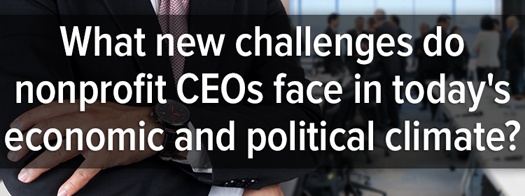What New Challenges do Nonprofit CEOs Face in Today's Economic and Political Climate?
In this struggling economy, charities and nonprofits are up against a number of pressing issues. All nonprofits, even well-funded grant makers, are likely to experience significant difficulties with the following issues over the next few years.
Managers must smooth relations between baby boomers and millennials
American charities have had to cope with a struggling economy for nearly a decade. Jobs for graduates are becoming a rarity, and older workers lack the savings they once relied on to retire with dignity. Tensions between younger staff members, with college degrees, and baby-boomer executives, with 70-hour/week workloads, has become a permanent fixture in nonprofit workplaces.
Income inequality raises difficult issues for donors
The widening gap between the upper and lower income brackets came into sharp relief early decade. As a result, philanthropists have to answer challenging questions regarding the real benefits they offer to society. This became a matter for debate over coveted 'charitable tax deductions,' as the President and others have made public statements saying it's time to rethink the tax breaks that are chiefly available to high-income earners. Some have been calling for wealthy donors to direct more of their large monetary gifts toward addressing poverty — rather than funding new buildings for their alma maters. In 2012, the question of how to improve opportunities for all Americans became a focus for the philanthropic agenda.
The pressure of diminishing government aid
With Washington's growing budget woes and subsequent pressure to cut back on state-funded aid, philanthropy is facing new demands in order to fill in the gaps resulting from tapering government aid. Philanthropists are being asked to give more and to redirect their gifts in order to safeguard the nation's existing safety net. However, private donors can rarely match the capabilities of big government coffers. A study found that the charitable households in the poorest states may be forced to increase giving by 60% just to keep pace with projected cuts in social services spending, Medicaid, and education. This may be too great a demand to fill. To help buffer the budget decline, grantmakers and nonprofits are having to increase advocacy efforts as well as lobbying activities.
Steering the debate away from overhead expenses
Charities continue to scrape bottom for meaningful ways to measure their ability to provide effective services to the communities they operate in — all the while donors are chomping at their heels. "Overhead ratio" — a nonprofit's share of the money it spends on administrative costs — is coming under the cross hairs of nonprofit experts. Still, these expenses remain a serious consideration for donors and regulators, and a satisfactory method of evaluation has yet to emerge to the current metrics. It may be unrealistic to hope that a new metric will emerge. Even still, since the first half of the decade, nonprofits everywhere have felt the pressure to answer the question: "What positive effect is your organization having for vulnerable populations?"
New approaches may be needed
Excitement over organizations that use for-profit business models to work out both social and environmental trouble have grown in popularity with thought leaders despite some resistance. States such as California have created corporate structures designed to enable companies to integrate a social purpose into their organizations and place social ends before profit. What this trend means for the nonprofit sector remains unclear. Will these hybrid structures give nonprofit groups a new lease on life or siphon off needed financial support?
With the winds of political change in the air, uncertainty also becomes an issue going forward. As trends and forecasts continue to set indicators on their ears, nonprofit CEOs will need to find new ways to look ahead. Will leaders turn to specialized forecasters to assist with decision making, or will a new panacea emerge?
With the winds of political change in the air, uncertainty also becomes an issue going forward. As trends and forecasts continue to set indicators on their ears, nonprofit CEOs will need to find new ways to look ahead. Will leaders turn to specialized forecasters to assist with decision making, or will a new panacea emerge?


